Daniela and Ion Iosif started with the idea of building a very comfortable house that would be easy to maintain in the future. And they ended up building a Premium Passive House certified by the Passivhaus Institute Germany. At this level, sustainability and energy efficiency are in the DNA of the project in all its phases, as well as in the level of workmanship, materials and equipment installed. The certification of the house was also part of the plan, because this way they were sure that every stage is well done and that the energy consumption for maintenance will not be more than 15 kWh/m² per year. Wood Industry News documented the whole project, from the erection of the first walls to the impressions after more than a year of living in the house. Find all the videos on The way home.
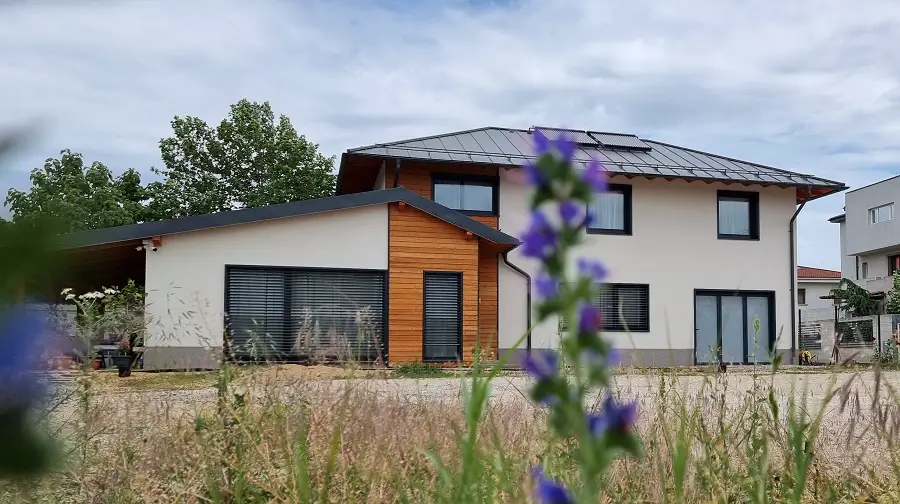
A house exactly as they wanted it
The first image that comes to mind about this project is Ion's joy at mounting the first wall of the house. It happened on 10.05.2021 and after the first day he was absolutely impressed with the speed at which the house had taken shape. Ion is an engineer, very meticulous and passionate about technical things, things well done and very tidy. Before he started building, he was inspired by the Buhnici House and went through all his videos Șoflete about building a house correctly, to understand and apply to his project what he thinks is right for him.
Now his experience may be an inspiration to others. We met on 8.05.2021, the day the house was being fitted and since then we have made about 20 visits to him. I also visited him a few times after he moved into the house in April 2022. Every time we see each other, Ion exudes justifiable pride in what their home now represents in terms of size, energy efficiency and most of all that it is the comfortable home he has thought through in detail. I asked him what he likes best about the house and he said, as if writing in capital letters: "EVERYTHING! I LOVE EVERYTHING! It's really, really good, there's a big difference in quality. Passive house gives you more comfort. You have optimal temperature, you have humidity correlated to temperature, which gives you increased comfort."
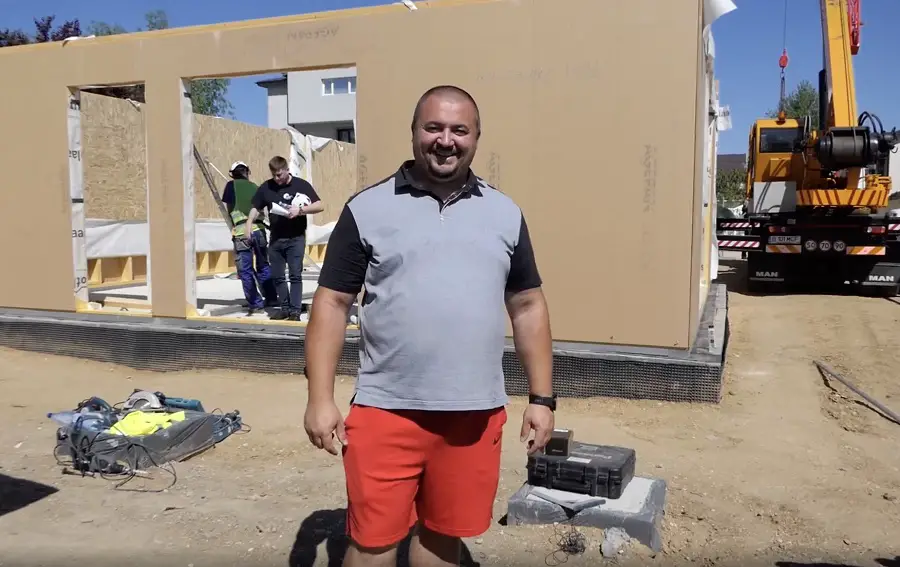
The beginnings and challenges of founding on troubled ground
Daniela and Ion Iosif decided in 2020 to build a house on the land they bought near Lake Pantelimon. They lived in Bucharest, in a 3-room apartment in a block of flats in the Titan district, Trapezului Square. When they bought the land, they chose the town of Pantelimon, near Bucharest, to stay close to places they knew well. They liked the area because it was quiet and the land near the lake and the forest was a good place for their future home. The ambition of this project was to make an architecturally simple house, sufficient as a space for them and their two children, built as well as possible exploring the potential of new technologies.
Work started in June 2020 with the foundation. It shouldn't have been a problem and it shouldn't have cost much because the foundations of wood-frame houses, which are lighter than brick or concrete, are simpler. It's just that the area proved to be difficult from a soil point of view. The geotechnical survey found that the land had a metre of soil, underneath which was a metre of household rubbish deposited on top of rubble from the 1977 earthquake.
The foundation could not be poured over the rubble, so it was first excavated to 3.5m, then filled with crushed concrete in layers and a cushion of ballast that were compacted. Before the foundation was poured, the ground was insulated with expanded glass aggregate for waterproofing and thermal insulation, after which the foundation was poured. Because of the soil, the foundation had to be of the general raft type with elevation. That is a lot more money in the foundation than would be needed for a timber frame house.
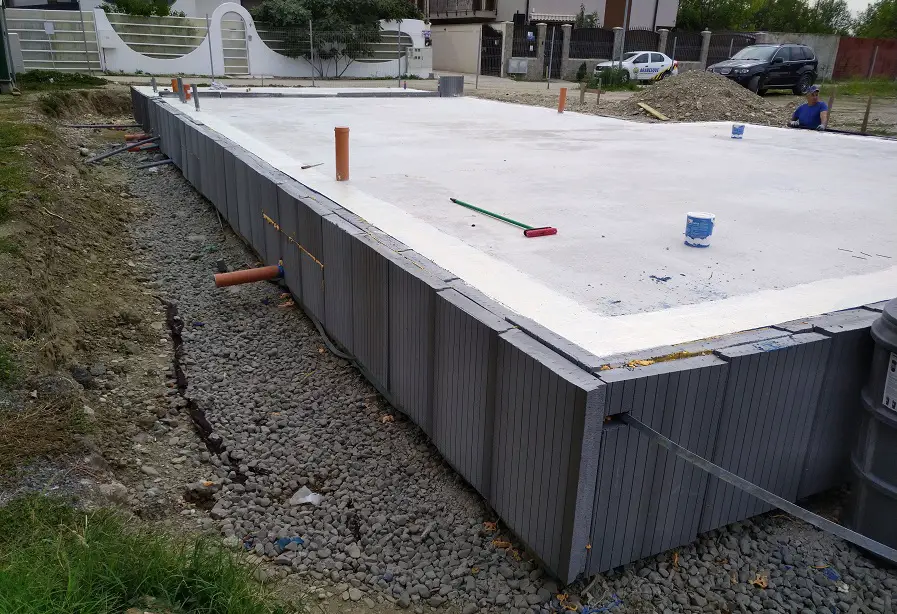
From the desire for increased comfort to certification as a PASSIVE HOUSE
"I didn't know from the beginning that I wanted a passive house. I wanted a house that would provide me with very good comfort. Later I discovered that the comfort I wanted in my new house corresponded to the passive house concept. I had some basic ideas and I knew what I wanted in a house, but I didn't have the bridges between these ideas. The Buhnici House project showed me these bridges, I discovered how to bring all the ideas together.
After discussions with the architect, we decided to make it a passive house. I wanted a house with mechanical ventilation, with underfloor heating, after what I saw at Buhnici, I wanted cooling in the ceiling and all this could only happen with very good insulation. And if you do all that, you're already pretty much within the cost range of a passive house. Sealing the house wasn't my idea, but since that's all that was missing until the passive house standard, I figured why not?
I didn't start from the idea of a passive house or that I wanted to be energy independent, but I wanted more comfort inside the house, because this is where we spend most of our time. From there it was just one step."
Since he was going to build a passive house, Ion decided early on to certify the house knowing that it was a guarantee that the work had been done well. While the house was being built, an energy consultant followed the entire construction process to prepare the necessary documentation for passive house certification.
"Having it certified, even though you're not getting any tax benefits at the moment, is an assurance that we've built it to a high standard. The actual cost for certification was not very high. The state should encourage passive houses to be built because in the end, we consume less energy, we burden the energy system less."
Wooden structure erected in a week
He had originally considered a metal-framed house, but it would have been harder to achieve passive house performance, so he decided the best solution was a prefabricated wooden structure. As the decision to make a passive house had already been made, attention was paid to the orientation of the house from the design stage, and to benefit from the sunlight all the windows were placed on the south side of the house, facing the lake and the courtyard.
The architecture of the house was designed to be as simple as possible, with easy access and maximum use of space. The house is ground floor + attic, with living room, kitchen, office, technical room, a bathroom and a workshop on the ground floor, and three bedrooms and two bathrooms in the attic. On the east side is the street from where the access to the courtyard is made. The back of the house is to the north, and on the west side the house continues with a covered terrace with access from the kitchen and dining room.
For the prefabricated wooden structure he worked with Litarh - Wooden houses. The team started with the floor layout on 8.05.2021 and after a week the ground floor, ceiling and attic were up. As insulation material, 15 cm mineral basalt plaster was used inside the exterior walls, plus 15 cm outside and 40 cm on the roof. Litarh took care of the structure, envelope and sealing of the house. A first blower door test was carried out on 14.06.2021, after the house was enveloped, to identify and remedy any possible airtightness problems.
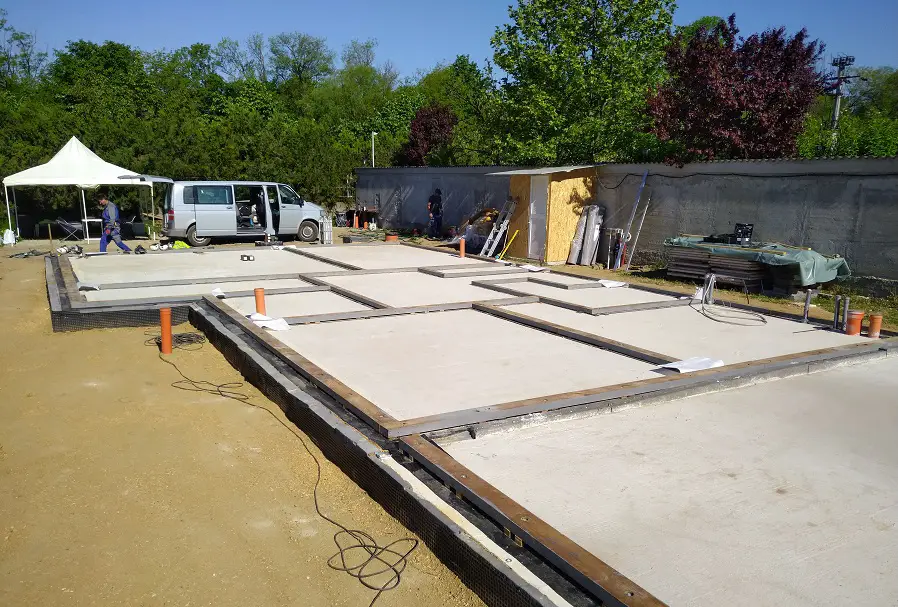
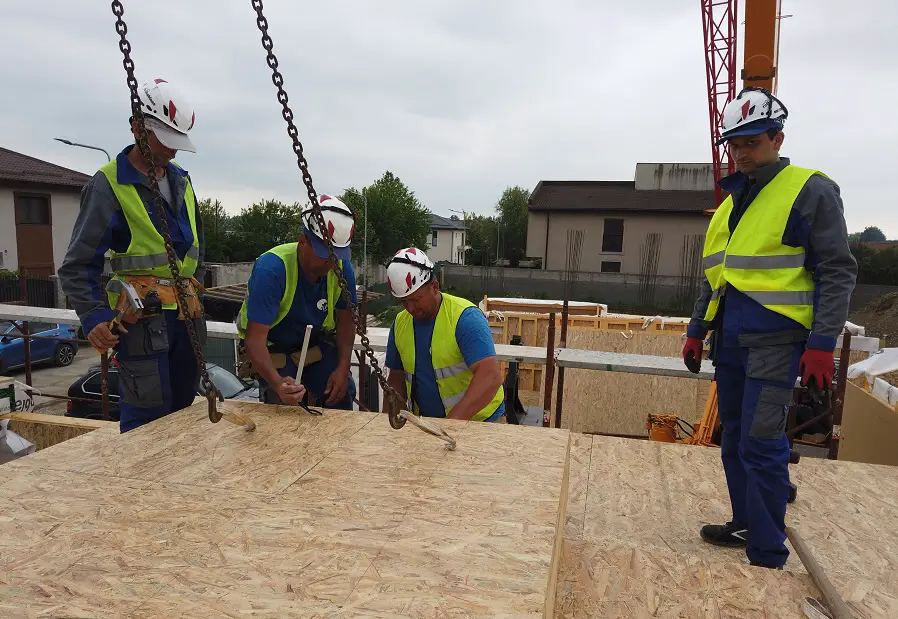
Passive house elements
Following the principles of a passive house, the Joseph house has mechanical ventilation to bring the necessary fresh air into the house and to regulate humidity. Heating throughout the house is through the floor using an air-to-water heat pump and cooling through the ceiling. Because it's a passive house, windows and doors play an important role. Not just any joinery can be fitted, but one that offers a high level of thermal insulation, windows that provide light all year round without compromising on thermal comfort.
The house was subjected to two leak tests to check for air leaks. Increased airtightness was ensured by eliminating uncontrolled air exchange with the outside through sensitive places (wall joints, wall/window joints, penetrations for electrical, thermal and plumbing routes). The careful workmanship in the final airtightness test produced a successful result that brought the house within the passive house standard.
The roof is so well insulated that Ion says he can't hear anything when it rains on the house. "Here we are talking about a system that has, starting from the inside: drywall board, air gap, sealing membrane, 40 cm basalt wool, HDF board, Rockwool membrane, lath, so another gap, OSB, bristle membrane and board. 10 items, so no chance of hearing anything. Absolutely no sound. The board was installed by Stelică (Stelian Stavarache, S.Y.S.PRO CONSTRUCT) With it we did the foundation, poured the liquid screed over the underfloor heating, did the sheet metal cladding and installed the photovoltaic system."
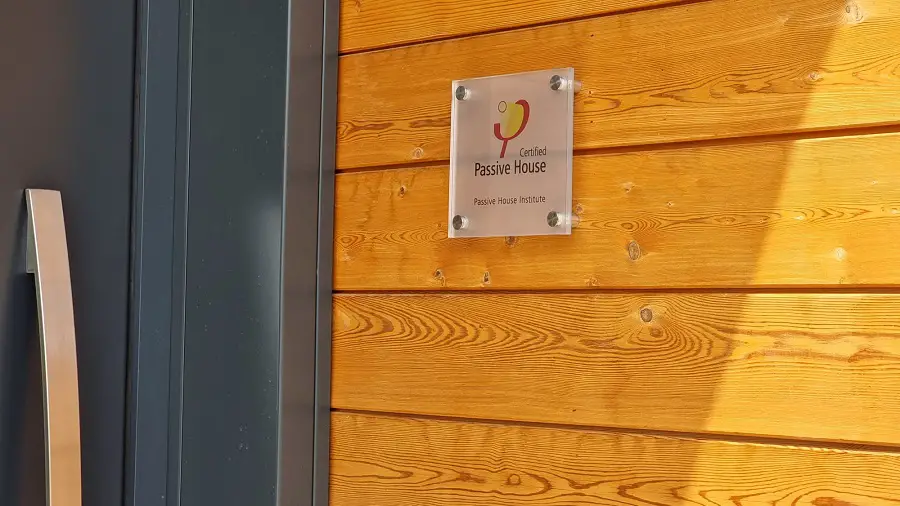
TECHNICAL ROOM - House Command Centre
A special room is the technical room, which Ion has provided with enough space to accommodate all the appliances and installations intended to increase the comfort of the house.
"We installed mechanical ventilation, which provides fresh air supply and humidity control. For domestic hot water we opted for a 300 litre capacity puffer with a heat pump that recovers heat from the mechanical ventilation before being exhausted outside and two solar panels on the roof for hot water. At the moment it is operating in economy mode, i.e. the electric resistance does not switch on. I have been running on economy mode since last September (2022). In economy mode the heat I get from the stale air and the solar panels is sufficient. We have 300 l of hot water at 62 degrees, before leaving for the bathrooms, we have a mixing valve that does not allow the hot water to leave with a temperature higher than 45 degrees, for safety reasons. There's also the ground water heat pump for heating and cooling the house, which uses a 100m-deep borehole through which the thermal agent passes in a closed circuit, a system that also has a 300-litre puffer to store the heat."
"We have smoke sensors and heat sensors connected to the burglar alarm centre for fire detection, as well as humidity sensors for flood detection. We also have a mobile powder fire extinguishing device installed to limit damage from potential fires in the electrical panel. And in the event of potential flooding, moisture sensors will operate a solenoid valve that shuts off the water supply to the house to limit potential property damage. In the rack serving the IT side, we have a UPS that, in the event of a power outage, keeps the whole system running until the backup generator is hooked up. Also in the technical room is the inverter for the photo-voltaic panels on the house."
Everything is neat, clean and labelled, from appliances to cables and pipes. Nothing is left to chance, Ion has a solution for everything. For example, the door stops are magnetic, wall-mounted. The sockets in the kitchen are concealed in the body of the wall-hung furniture, making it very practical and much more aesthetically pleasing. Because a smoke sensor in the kitchen could set off false alarms from steam from cooking, he fitted a thermal sensor that only goes off in the event of excessive temperature, specifically in the event of a fire. Although the cooker is induction and unlikely to trigger a fire, even this small risk is covered. There are many cleverly "hidden" details that Ion shows us, but the one that obviously catches your eye is the flooring.
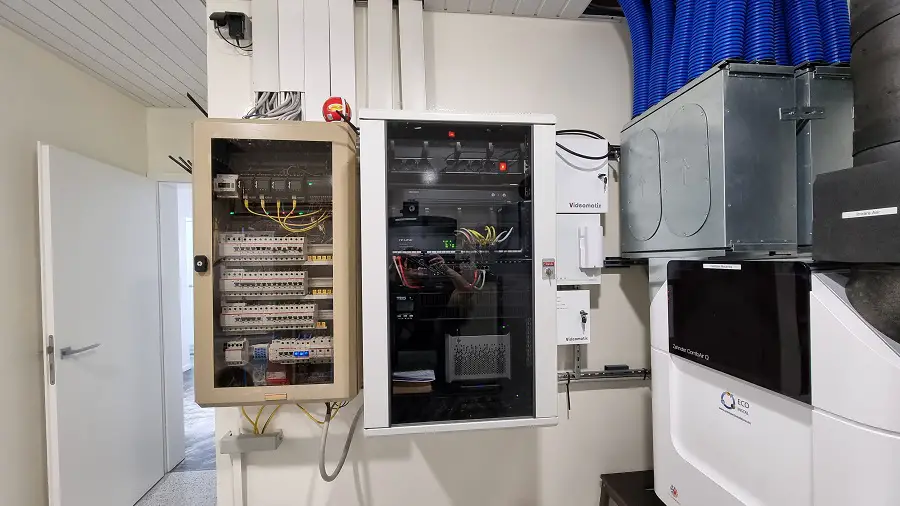
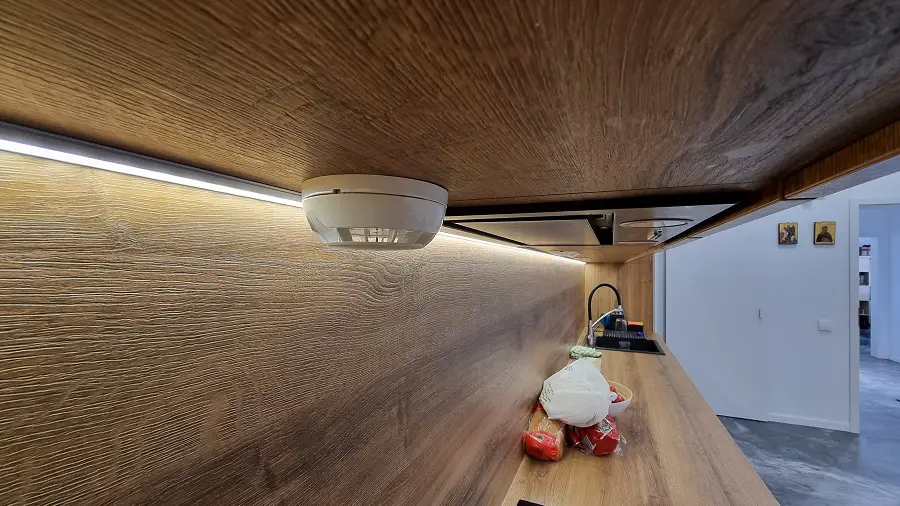
Epoxy resin flooring
"To make a good house you have to be open to trying new things, to be open to solutions. I've been watching tutorials on Youtube for some time and I've seen that, especially in America, they use (epoxy resin) as a finish in residences. It didn't seem complicated and I said let's give it a try. Epoxy resin supplier through Mr Eduard Wurtz assured us that it was not difficult to implement and gave us all the technical support we needed. And we poured it ourselves, inexperienced, we who have painted maximum one chair in our life.
We started by testing in the master dressing room, a very small room, and the result was spectacular. We continued in the loft, room by room, because there we have sliding doors and physical demarcation between floors. We left the downstairs at the end because we have no wainscoting and it had to be poured in one operation. Upstairs we chose a grey background with copper accents to match the brown of the sliding doors. The base resin is transparent and metallic pigments are added into it to achieve different colours. In appearance it gives the impression of marble. It's easy to maintain, has no joints, you can practically throw a bucket of water on the floor and mop it up without creating any damage."
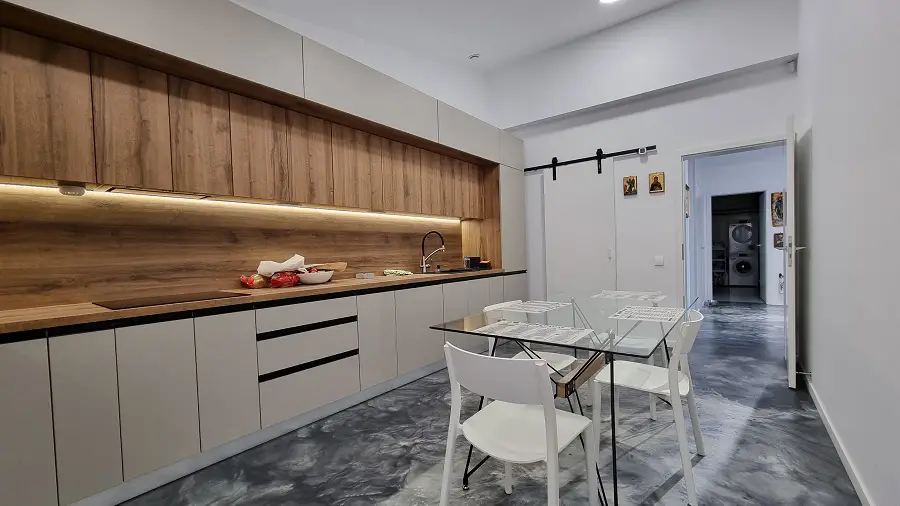
What's hard about building a PASSIVE HOUSE
"I think the idea of hard is largely about money. I also think that if you don't have someone to manage the project, construction can be a nightmare because all the stages are closely linked to each other. You have to know what and when to build. Even if you have the design, you need to know the stages and their order, know when to set start dates with various teams of fitters. I was lucky that during the time I was doing the house I had the time to devote to the construction.
There are also many things you need to think about beforehand, anticipate and remember. There have been episodes that I forgot and remembered in the twelfth hour. For example, I had the sound system to install in the living room and the cables had to be pulled before I could close the ceiling and put the cooling through the ceiling. I had the system, I had the cables, I was there, but I found after the ceiling and the cooling was installed that I didn't pull them. I finally found a solution suggested by the painter and ran the cables across the ceiling between the two cooling runs.
Also, when I poured the foundation, I thought about having two inlets through the foundation for strong currents and two for weak currents. Only I didn't think of making them with larger diameter pipe, e.g. 100 mm and put 50 mm diameter pipe. Now, if I am to put another cable in, there is no more room through the pipe now running through the foundation. There were small, very small oversights. Even when you know them, there can still be slip-ups."
What would they do otherwise?
"I would catch the technical gaps for installations at the design stage. That means passages between floors, between rooms, for electrical, thermal and plumbing installations. They were quite difficult to execute when we pulled them. The technical gaps for installations should be included in the design phase."
Choosing the smart home system
"I had a hard time deciding which smart home system to choose for my home. I knew I wanted the smart system, I knew I wanted to control certain elements, if not all, but I didn't know which system to choose. I knew about KNX, but it's a very expensive system. Very good, but not unduly expensive. I pulled the wiring myself, but for the smart home what cable should I pull, how should I pull it, what type of lights should I put in, smart or not, what switches?
I chose to make the power system smart, in the sense that I made the power to the lights smart, to control the power system. That means I can put in any kind of bulb - incandescent, led, neon, whatever. Choosing this system meant no need for switch sockets. I chose wireless switches that control relays directly in the technical room. We pulled dedicated circuits, the cable directly into the technical room and the wireless switch can be mounted anywhere because it controls the relay that operates the light in that room. So we have a smart power system.
We saved a lot of money, I think we also saved on labour, because we didn't put in any more connection plugs, we didn't put in any more switch plugs because they just stick to the wall. We chose kinetic switches, which don't need batteries. They produce enough energy when you push the button to send the pulse to the relay."
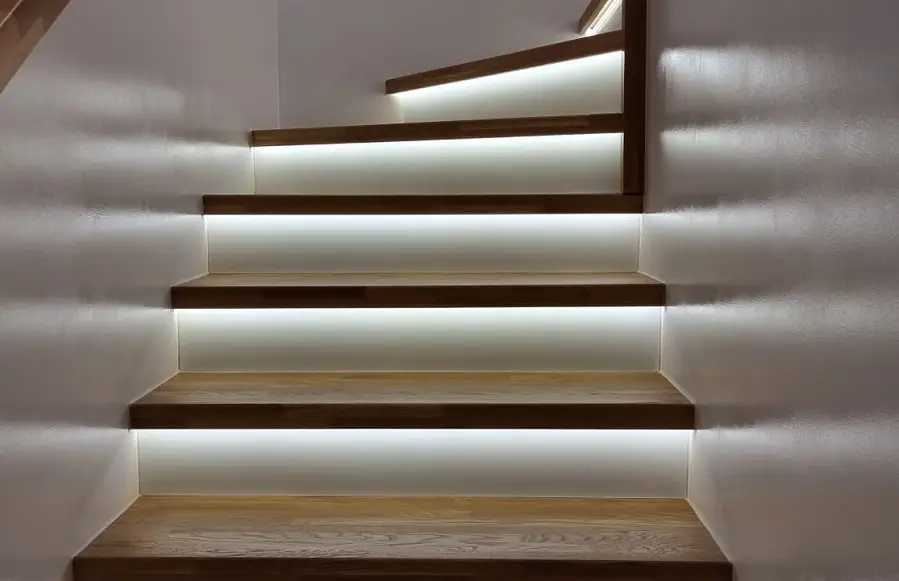
3 essentials for building a good home
"Documentation, first and foremost. You have to know what you want to do, understand and know what you're looking for. Then go and see projects done by those you want to work with, find out how they have performed over time, ask for feedback from the beneficiaries!
Design. I think Romanians don't give it the importance it deserves. They get a house project just to get the building permit, and when they start building, wait, I don't want that here. A project is like a domino, if you change one part, it affects another. A well done and followed step by step execution project saves you a lot, you can do the material requirements, cost estimates. The site manager has to check that everything is done according to the project. If you don't work according to the design, what a job well done, you have no guarantee. Everyone has their share of experience, of work, of responsibility. A lot of people try to skip certain stages, considering them unnecessary costs or we do it because it is required. For me, the project is super essential. You can't do something if you don't have the design and the craftsmen working according to the design.
So, yes, documentation, design, craftsmanship for execution - these are the 3 essentials to building a house well."
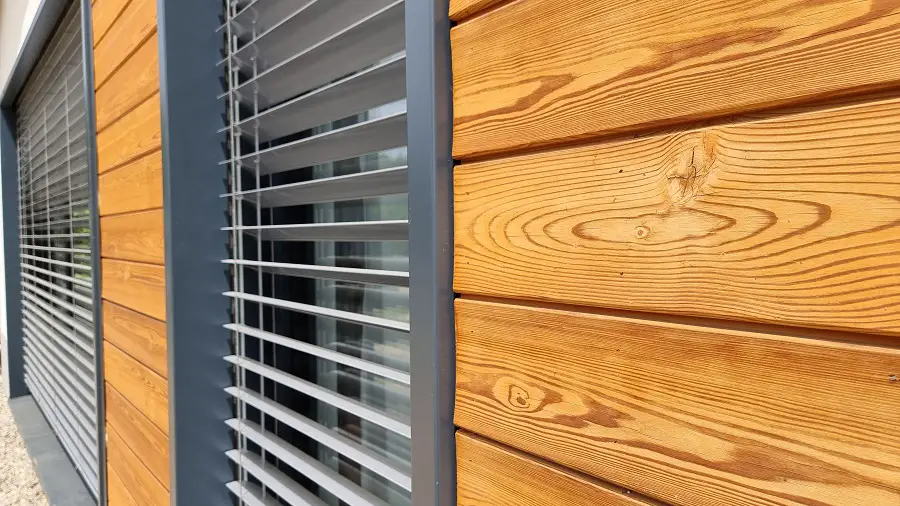
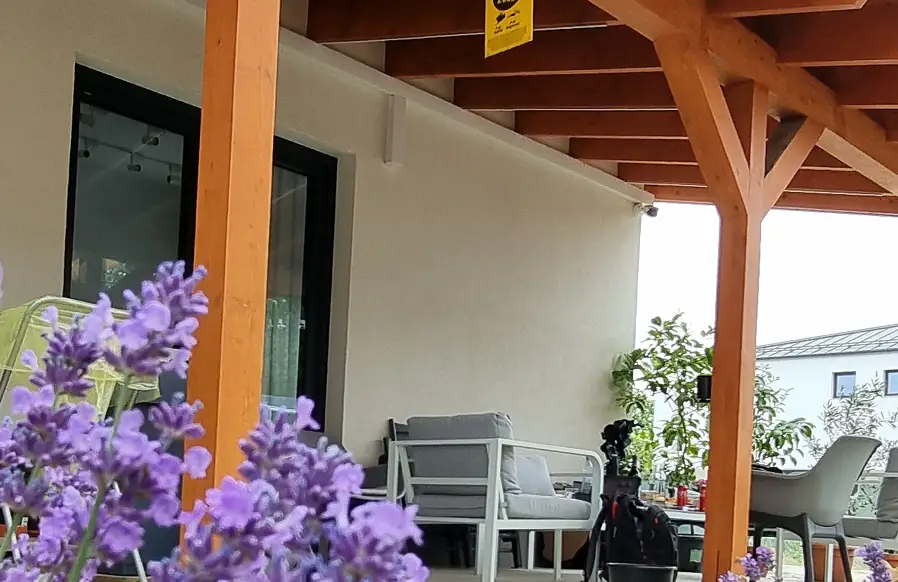
Costs
The positive construction experience was also helped by the efficient material sourcing strategy. With the money available, they went for the strategy of purchasing materials and installations early and getting discounts for full payment. They bought in advance the heating and plumbing, security system and cameras, roof. They made significant savings.
"When we started construction, exactly one month later, the price increase started. How much we spent is no longer relevant as many of the prices of the materials used have now increased. The cost of the house was up to 350,000 euros, of which the foundation was 40,000 euros. On the foundation I could have saved most of the money if the soil had been suitable. As finishes, the most costly were the plastering for the cooling ceilings because it needs big coating and special materials, plus the labour which was more expensive.
The flooring is all epoxy resin and here we saved the workmanship because we did it ourselves. 70 sq m upstairs, the cost to lay flooring for underfloor heating would have taken us with materials and labour to 10000 euros (70 sq m upstairs only). The resin took us to 6000 euro for the whole house 170 sqm (ground floor + first floor).In addition, we have a practical floor, very easy to maintain and provides optimal heat transfer, I think the best. I am very, very satisfied."
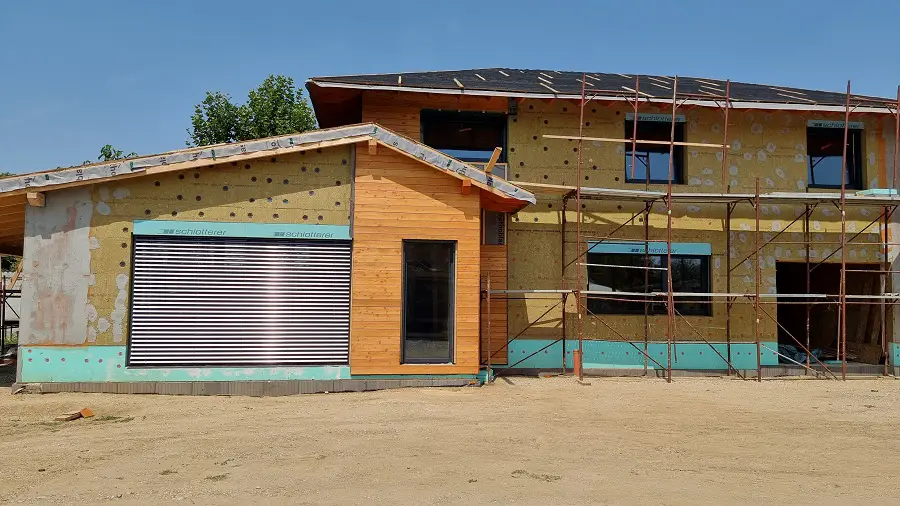
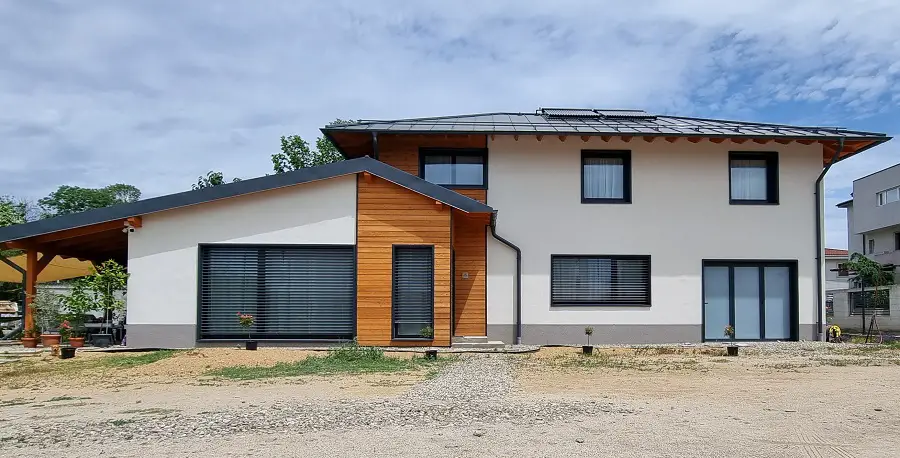
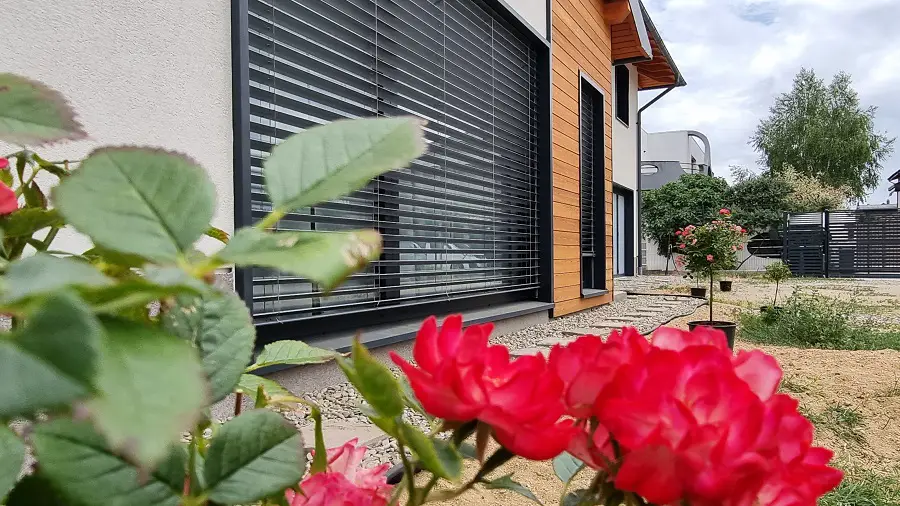
After a year and a half living in a passive house
As it is now, more than a year into living in the premium passive house.
"Being a timber-framed house, after a year I was expecting cracks in the plaster, but we don't have that. There is no sound from the other floors, no movement, no creaking, no noise, even from one room to another on the same level. Next we're going to do a summer kitchen and a carport, also on wood structure they will be.
If I were to build another house, I would still build a passive house, without any doubt. So much do I like the comfort I have now that I couldn't conceive of anything less. The air quality is excellent in the house, we have in addition to a constant supply of fresh air and humidity control. The mechanical ventilation works by introducing fresh outside air through the living room and bedrooms with exhausting stale air through the kitchen, bathrooms and technical room.
In the summer it's cool in the house from the ceilings with cooling coils, and in the winter there's plenty of heat coming from the floor. We have all the comfort, I don't think there is anything that could increase our comfort more at the moment. We've already gone through all the seasons, with a very hot summer. Heating/cooling consumption does not exceed an average of 5kw/day for 170 sqm. At the moment we spend less than 5kw/day for heating-cooling, but the photovoltaic system is not yet commissioned."
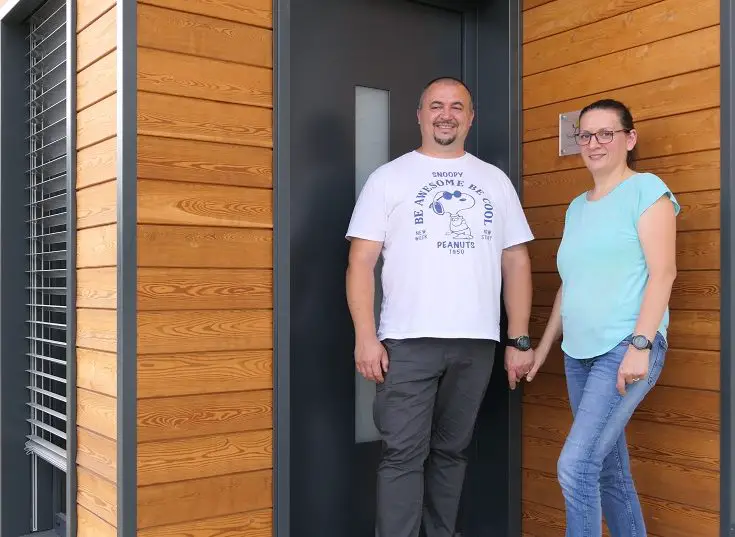
Ion and Daniela set out with the idea that their future home would be very comfortable, with no wasted space, a modern and comfortable home that would protect them from high costs in the future. That's how they ended up building a passive house. The passive house standard is currently the way to essentially solve the problems of energy, comfort and indoor living quality. It's not easy to build a house. It takes time and thought. It takes planning, prioritising 'wants and needs' and analysing available options that overlap with your budget. Ion decided to get 100% involved in building the house and to contract specialized and experienced firms/teams on each stage of construction.
In August 2022, the House by the Lake received the Passivhaus Institute's Classic Passive House certification. At the time you are reading this, since the photovoltaic panel system has already been installed and put into use, the House by the Lake qualifies and has received the Passive House Premium certification, being one of the 3 houses in Romania certified at this level.
DETAILS: Passive dwelling Gf+M Surface: 236 sqm
Architecture: arh. Raluca Munteanu / arh. Sandra Șonei - Arhi.Mede Studio
Structure project: ing. Cătălin Caraza - Creative Engineering Design Office
Installations project:ing. Cornel Stanciu - Instal Studio
Structure construction:: Litarh Wooden houses
Windows:Internorm KF410
Ventilation system with heat recovery: Zehnder ComforAir Q350 - EcoInstal IT Consult
Passive house certification: Ing. dr. Varga Szabolcs - V&V Projekt
Energy consultancy: arh. Adriana Sîngeap - BIA













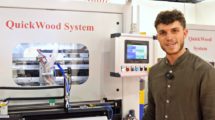





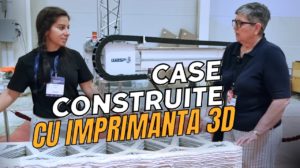
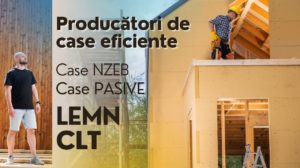
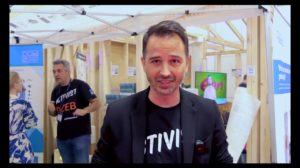
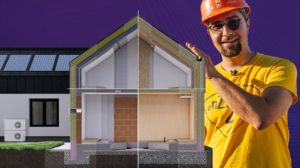

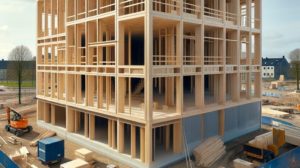
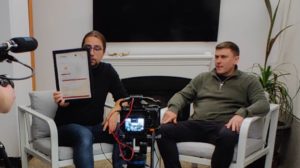
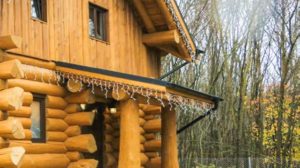
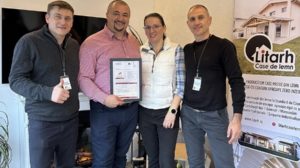

Add comment